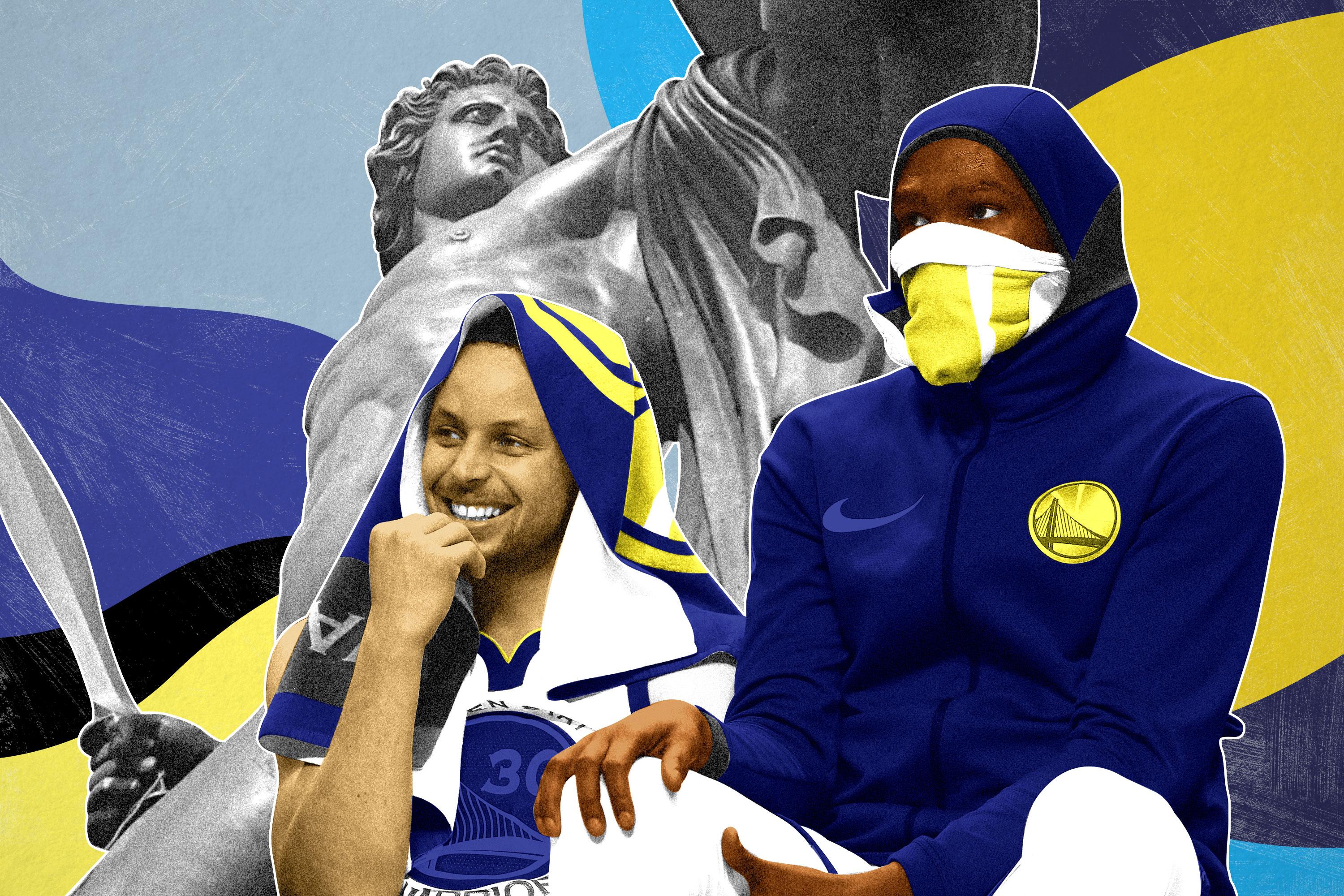
The NBA regular season rewards consistency and a well-executed system. The six-month, 82-game slog brings too much rotation juggling and too many opponents to properly adjust every game, so the best teams get ahead with an approach that can function almost regardless of context.
But the playoffs are a different challenge. The playoffs are where Ryan Anderson and Enes Kanter can’t play because of their defense, and where Tony Allen’s offensive inadequacy paves a pathway to the Finals for a budding dynasty. If a title contender stumbles into the wrong matchup, it can suffer an early elimination—and face difficult questions during the next summer as player movement continues apace.
So what are the potentially exploitable weaknesses for this season’s contenders? We’ve picked out one teamwide issue for each of the nine squads with at least a 1 percent chance of reaching the Finals, according to FiveThirtyEight’s projections, plus Portland, both to make it an even 10 and because Charles Barkley’s prediction carries just as much analytical weight. In all of these cases, the problem in question isn’t by itself a death knell for the team’s Finals hopes, but if that team falls behind in an otherwise winnable series, there’s a fair chance that the flaw will be the reason why. (Unless otherwise noted, rate statistics come from Cleaning the Glass, which strips away garbage-time minutes, to better reflect the reality of playoff rotations.)
Warriors (75 percent chance of reaching the Finals): Free points in transition and off turnovers
Why It’s a Problem: As the team’s favorable odds suggest, it’s difficult to find too much to quibble with in Golden State’s numbers. But one area does stand out as a concern: The Warriors rank 25th in allowing fast-break points, per NBA.com/Stats—the worst of any playoff team—and 22nd in allowing points off turnovers. That’s essentially where they rated before DeMarcus Cousins’s return from injury in mid-January, too, so it’s not a result of trying to incorporate the historically turnover-prone center into the offense. It isn’t a huge deal given Golden State’s style of play—the Warriors rank second in fast-break points on offense—but against the wrong opponent, in the wrong situation, the Warriors’ penchant for turnovers could prove costly.
Who Might Exploit It: The Thunder force turnovers at the NBA’s second-highest rate, and they lead the pack in points off turnovers, according to NBA.com/Stats, at 19.8 per contest. Indeed, against the Warriors this season, Oklahoma City has forced 19 turnovers per game—Golden State’s worst average against any opponent.
Bucks (44 percent): 3-pointers allowed
Why It’s a Problem: Milwaukee is in a virtual tie with Utah for first place in defensive rating, allowing 105.4 points per 100 non-garbage-time possessions. The Bucks allow the lowest effective field goal percentage, the lowest offensive rebounding rate, and the lowest free throw rate of any team, in large part because of a refined defensive philosophy that knows exactly where it wants to prevent shots, and where it’s comfortable permitting them. No team allows fewer shots at the rim, and no team allows a lower shooting percentage at the rim, either.
That dominance near the basket comes at the expense of dominance on the perimeter, though. The Bucks allow the second-highest rate of 3-point attempts, and opposing shooters convert those tries at an above-average 36 percent clip. Milwaukee intentionally funnels those looks to bad shooters, but leave an NBA player open long enough and he’ll probably start hitting some. Based on the identity of opposing shooters and the locations from which they shoot, Milwaukee has reduced field goal percentages within 6 feet of the basket by 4.6 percentage points, the best such mark in the league. On 3-pointers, though, opponents have shot better than would be expected by their performances against every other team.
Who Might Exploit It: Ironically, the Bucks would be ideally suited to score on the Bucks, as Milwaukee takes the most 3s of any team besides the outlier Rockets. Beyond Milwaukee, the Nets, a potential first-round opponent, take the fourth-highest rate of 3s, and the Celtics, a potential second-round opponent, rank sixth. Both of those teams rank among the top dozen in the league in 3-point accuracy as well.
That’s no guarantee of success against Milwaukee, of course. In two games against the Bucks, the Nets took 77 3-pointers but converted at only a 26 percent rate—the lowest percentage for all of Milwaukee’s opponents this season. Toronto has also shot poorly against Milwaukee this year, making just 31 percent of its 37 3-point attempts per game. But Boston fared better, canning 37 percent of its 43 triples per game against the Bucks, and those are such small samples that they’re probably not predictive of potential playoff success regardless.
Raptors (38 percent): Overreliance on transition
Why It’s a Problem: The Raptors offense ranks seventh in points per possession, which is also the East’s best mark outside Milwaukee. But that ranking comes in large part because the Raptors add 4.8 points per 100 possessions through transition play—the best for any team. By half-court performance alone, the Raptors rank 14th in offensive efficiency, behind a half-dozen Eastern teams: Milwaukee, Boston, Washington, Philadelphia, Brooklyn, and Charlotte.
Who Might Exploit It: The Celtics allow the fewest transition opportunities of any team, while the 76ers—who do allow a fair amount of transition—are the best in the league at preventing points in transition play. If those potential second-round opponents squeeze out Toronto’s easy points, the Raptors’ overall offensive output could wither in May once again.
Rockets (12 percent): Defensive rebounding and paint defense
Why It’s a Problem: The Rockets have allowed opposing teams to collect 29 percent of their own misses via offensive rebounds; only the Suns have done worse. The Rockets have also allowed teams to shoot 67 percent at the rim, which ranks 29th. Those numbers are so poor that Clint Capela’s 15-game absence alone can’t explain them. They looked just as bad before his midseason injury, anyway.
Who Might Exploit It: The Nuggets lead the league in offensive rebounding rate. The Trail Blazers rank fourth. The Thunder rank fifth. Moreover, Oklahoma City ranks fourth in the league in the percentage of its shots that come near the rim, while the Jazz rank sixth and the Blazers seventh. In other words: Basically every non-Warriors team in the top six in the West poses a particular problem for Houston given the Rockets’ defensive disadvantages—and the Warriors, of course, bring their own challenges to any series.
76ers (9 percent): Turnovers
Why It’s a Problem: The 76ers rank 27th in turnover rate this season, and the only teams below Philadelphia are the Suns (a team without a real point guard), the Heat (a team without a real point guard), and the Hawks (a team with a rookie point guard). Overall, Philadelphia fields a strong but not overwhelming offense, ranking 12th in points per possession. But the team shoots well (eighth in effective field goal percentage) and reaches the line at an extraordinary rate (second); it’s the turnovers that get in the way and prevent the Sixers’ offense from ascending to the league’s upper echelon. The whole offense, it’s worth noting, looks much worse since Tobias Harris arrived at the trade deadline (23rd in efficiency, 20th in eFG%, 29th in turnover rate), but given all the moving parts in Philadelphia’s rotation over the past month—including an extended Joel Embiid absence—the turnover rate is the persistent concern.
Who Might Exploit It: The Celtics and Raptors both force turnovers at a top-10 rate, and they’ve both done well to turn those turnovers into points: Toronto leads the league in offensive efficiency in transition, while Boston ranks fifth. The Pacers, meanwhile, lead the league in forcing turnovers, after ranking second last season.
Celtics (9 percent): Lack of free throws
Why It’s a Problem: The Celtics have taken just 0.21 free throws for every field goal attempt, the lowest rate this season and the fifth-lowest rate in NBA history. That’s in large part a reflection of the times, as the modern game’s spread and rise in 3s have yielded the lowest leaguewide free throw rates in history. But Boston in particular has suffered the affliction. Veterans Kyrie Irving, Al Horford, and Gordon Hayward have all seen their free throw rates plummet to career lows this season, as have young players like Jayson Tatum and Jaylen Brown, who are getting to the line less now than they did in their first seasons in the league. This teamwide trend is evidently by design, but it’s unclear whether such an extreme avoidance of a key route for points will work in a playoff series.
Who Might Exploit It: The Bucks surrender the fewest free throws in the league, which sets up a potentially fascinating strategic paradox if Milwaukee and Boston meet in the playoffs. The Bucks don’t allow free throws, while the Celtics don’t even try for them; the Bucks have calculated that it’s worthwhile to let teams rain 3s, while the Celtics have calculated that it’s worthwhile to keep shooting from distance. Two strengths vs. two weaknesses—which advantage would overpower the other?
Thunder (7 percent): Shallow bench
Why It’s a Problem: It’s a tricky job disentangling starter vs. bench lineups, but any honest look at the Thunder’s bench this season reveals the same impression. One accounting, per Hoops Stats, ranks the Thunder’s bench 27th in net rating, and simpler measures confirm this sentiment. The Thunder have been outscored when Paul George is off the court. They’ve been outscored when Steven Adams is off the court. They’ve been outscored when Jerami Grant is off the court. And they’ve been almost outscored (net rating of plus-0.2) when Russell Westbrook is off the court.
Compare that situation with, say, the Nuggets’. Every member of Denver’s roster has a positive off-court net rating. Depth isn’t as important in the playoffs as the regular season because lineups shorten and the stars’ minutes increase, and coach Billy Donovan could stagger George’s and Westbrook’s minutes more to ensure that one of his stars is on the court at all times. But that idea might not be a panacea: While the Thunder have a healthy net rating of plus-7.8 when George plays without Westbrook this season, that rating flips to minus-6.7 when Westbrook plays without George. Depth continues to be a problem for the Thunder; it has cost them in the playoffs before.
Who Might Exploit It: The Clippers and Spurs both boast top-five benches per Hoops Stats, though those teams are likely to settle into lower seeds and thus probably won’t face the Thunder (currently fourth in the conference) in the first round. Beyond those bottom-rung Western playoff teams, the Nuggets’ depth is a strength. Denver’s bench could give the Thunder fits in a potential clash.
Nuggets (3 percent): Corner 3s allowed
Why It’s a Problem: One in 10 shots the Nuggets have allowed this season have been corner 3s, the highest proportion in the league. And this isn’t a Bucks-style effort to consciously direct attempts to poor shooters; those opponents have converted their corner looks at an above-average 39 percent rate. Denver’s defense has looked better over the past month, after a concerning midseason swoon, but the team allows too many easy points for a team that wants to reach the Finals.
Who Might Exploit It: The Rockets and Jazz, respectively, rank first and second in percentage of corner 3s taken on offense. The Spurs, meanwhile, haven’t dialed that number often—they rank 28th in attempts—but experienced fantastic success when they have: They’re making 47 percent of their corner 3s. If the Spurs face Denver in the first round, Gregg Popovich is smart enough to poke at that weakness until it bursts.
Jazz (3 percent): Lack of star power
Why It’s a Problem: The first NBA All-Star Game was in 1951. Since then, out of 134 teams that reached the Finals (not counting the two 1999 teams, because that lockout canceled the game), only one did so without a single player who was named an All-Star that season. That team was the 1977-78 SuperSonics. So if Utah makes the Finals, it would achieve something that no team has done in more than 40 years.
That’s not entirely fair to the Jazz, whose center, Rudy Gobert, is the reigning Defensive Player of the Year and should have been an All-Star this season. (We ranked Gobert 14th this season among all players around the All-Star break.) But it speaks to one of Utah’s larger problems: The NBA is a strong-link sport, meaning the best players impart the most influence on a team’s success, and the Jazz’s strongest link isn’t as strong as those of almost every other successful playoff team in league history.
Who Might Exploit It: Every other team that received a blurb in this piece had a 2019 All-Star. Utah is a very good team—but in this respect, it’s David fighting a whole pack of Goliaths.
Trail Blazers (less than 1 percent): Pick-and-roll defense
Why It’s a Problem: Pick-and-roll ball handlers have finished 21.2 percent of offensive possessions against the Blazers this season—the highest rate against any team, per NBA.com/Stats. And they’ve scored 0.92 points per possession on such plays—the second-highest rate against any team. Whichever team draws Portland in the first round has a clear plan to outscore the Blazers.
Who Might Exploit It: The good news for Portland is the NBA’s best team in pick-and-roll offense is the Blazers, and Damian Lillard can’t score against himself. Besides Portland, the most efficient pick-and-roll team is the Warriors, but a Golden State ball handler finishes off the play in just 11.2 percent of offensive possessions, the second-lowest of any team. So Golden State could exploit this weakness if it wanted, but that doesn’t fit the Warriors’ offensive strategy. (Nor is it likely that Golden State is saving the trick for the playoffs; the Warriors haven’t noticeably boosted this rate in prior postseasons.)
If not Golden State, then the Clippers could effectively exploit Portland’s problem. L.A.’s best team—sorry, LeBron—uses pick-and-rolls on more possessions than any other team and scores at a healthy clip, while the Jazz rely on the pick-and-roll a great deal as well, though to less impressive results.

